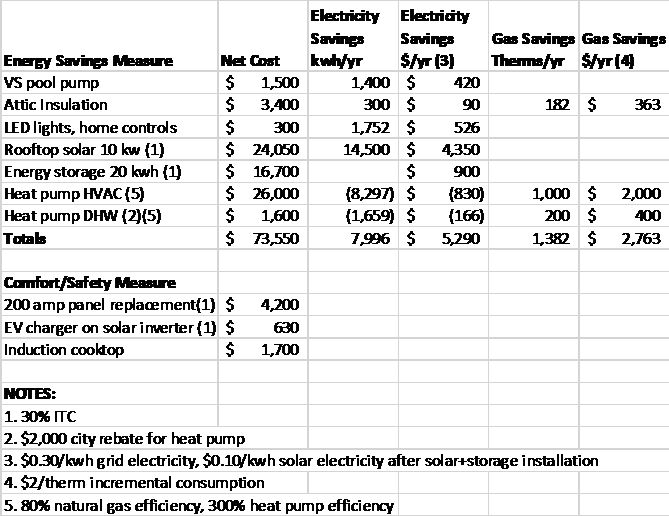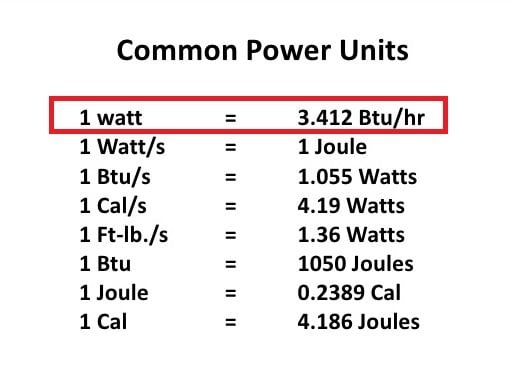To Find BTUs From Electrical Values. Known and Given: 1 kW = 3413 BTUs (or 3.413 kBTUs) The above is a generally known value for converting electrical values to BTUs. Many manufacturers publish kW, kVA and BTU in their equipment specifications. Often, dividing the BTU value by 3413 does not equal their published kW value. How to convert BTU/hr to watts. 1 BTU/hr = 0.29307107 W. So the power P in watts (W) is equal to the power P in BTUs per hour (BTU/hr) times 0.29307107 and is equal to the power P in BTUs per hour (BTU/hr) divided by 3.412141633. 1 BTU/h = 0.7222 VA. 1 x 0.7222 VA = 0.7222 Volt Ampere. Always check the results; rounding errors may occur. Convert Amps Into Btu; Re: Conversion of Amps to BTU You don't need to consider time with watts. Volts = watts Watts. 3.4 = btu This is a perfect scenario of course not taking into account ambient temp of room and perfect efficiency. Personally consider doubling your btu for cooling on this equation to be safe and allow small amount of. Aug 07, 2020 Here’s how we can calculate how many amps such 10,000 BTU air conditioner draws: I (in Amps) = 10,000 BTU / (12 x 115V) = 7.25 Amps We see that this AC unit uses 7.25 amps to deliver 10,000 BTU of cooling power. Comparatively, the 5,000 BTU AC unit from Example 1 delivers 5,000 BTU of cooling power using 4.35 amps.
Calculation formulas
Current:
The phase current I in amps (A) is equal to the real power P in watts (W), divided by the product of the power factor PF and the RMS voltage V in volts (V): I = P / (PF * V) The phase current I in amps (A) is equal to the apparent power S in volt-amps (VA), divided by the RMS voltage V in volts (V): I = S / V
Apparent Power:
The apparent power S in volt-amps (VA) is equal to the product of the voltage V in volts (V) and the current I in amps (A): S = V * I The apparent power S in volt-amps (VA) is equal to the real power P in watts (W) divided by the power factor PF: S = P / PF
Active or Real Power:
The power P in watts (W) is equal to the product of the phase current I in amps (A), the RMS voltage V in volts (V), and the power factor PF: P = I * V * PF The real power P in watts (W) is equal to the product of the apparent power S in volt-amps (VA) and the power factor PF: P = S * PF
Heating/Cooling:
The formula to convert power in watts (W) into BTU(IT) per hour (BTU/h): P(BTU/h) = 3.412141633 * P(W) The formula to convert power in BTU(IT) per hour (BTU/h) into tons of refrigeration (TR): P(TR) = P(BTU/h) / 12000
AC BTU Calculator
Use this calculator to estimate the cooling needs of a typical room or house, such as finding out the power of a window air conditioner needed for an apartment room or the central air conditioner for an entire house.

General Purpose AC or Heating BTU Calculator
This is a general purpose calculator that helps estimate the BTUs required to heat or cool an area. The desired temperature change is the necessary increase/decrease from outdoor temperature to reach the desired indoor temperature. As an example, an unheated Boston home during winter could reach temperatures as low as -5°F. To reach a temperature of 75°F, it requires a desired temperature increase of 80°F. This calculator can only gauge rough estimates.
What is a BTU?

The British Thermal Unit, or BTU, is an energy unit. It is approximately the energy needed to heat one pound of water by 1 degree Fahrenheit. 1 BTU = 1,055 joules, 252 calories, 0.293 watt-hours, or the energy released by burning one match. 1 watt is approximately 3.412 BTU per hour.


BTU is often used as a point of reference for comparing different fuels. Even though they're physical commodities and quantified accordingly, such as by volume or barrels, they can be converted to BTUs depending on the energy or heat content inherent in each quantity. BTU as a unit of measurement is more useful than physical quantity because of fuel's intrinsic value as an energy source. This allows many different commodities with intrinsic energy properties to be compared and contrasted; for instance, one of the most popular is natural gas to oil.
BTU can also be used pragmatically as a point of reference for the amount of heat that an appliance generates; the higher the BTU rating of an appliance, the greater the heating capacity. As for air conditioning in homes, even though ACs are meant to cool homes, BTUs on the technical label refer to how much heat the air conditioner can remove from their respective surrounding air.

Size and Ceiling Height
Obviously, a smaller area room or house with shorter lengths and widths requires fewer BTUs to cool/heat. However, volume is a more accurate measurement than area for determining BTU usage because ceiling height is factored into the equation; each three-dimensional cubic square foot of space will require a certain amount of BTU usage to cool/heat accordingly. The smaller the volume, the fewer BTUs are required to cool or heat.
The following is a rough estimation of the cooling capacity a cooling system would need to effectively cool a room/house based only on the square footage of the room/house provided by EnergyStar.gov.
| Area To Be Cooled (square feet) | Capacity Needed (BTUs per hour) |
| 100 to 150 | 5,000 |
| 150 to 250 | 6,000 |
| 250 to 300 | 7,000 |
| 300 to 350 | 8,000 |
| 350 to 400 | 9,000 |
| 400 to 450 | 10,000 |
| 450 to 550 | 12,000 |
| 550 to 700 | 14,000 |
| 700 to 1,000 | 18,000 |
| 1,000 to 1,200 | 21,000 |
| 1,200 to 1,400 | 23,000 |
| 1,400 to 1,500 | 24,000 |
| 1,500 to 2,000 | 30,000 |
| 2,000 to 2,500 | 34,000 |
Insulation Condition
Thermal insulation is defined as the reduction of heat transfer between objects in thermal contact or in the range of radiative influence. The importance of insulation lies in its ability to lower BTU usage by managing as much as possible the inefficient wasting of it due to the entropic nature of heat – it tends to flow from warmer to cooler until there are no longer temperature differences.
Generally, newer homes have better insulating ability than older homes due to technological advances as well as a more strict building code. Owners of older homes with dated insulation that decide to upgrade will not only improve on the ability for the home to insulate (resulting in friendlier utility bills and warmer winters), but also have the value appreciation of their homes.
The R-value is the commonly used measure of thermal resistance, or ability of heat to transfer from hot to cold through materials and their assembly. The higher the R-value of a certain material, the more it is resistant to heat transfer. In other words, when shopping for home insulation, higher R-value products are better at insulating, though they're usually more expensive.
When deciding on the proper input of insulation conditions into the calculator, use generalized assumptions. A beach bungalow built in the 1800s with no renovations should probably be classified as poor. A 3-year-old home inside a newly developed community most likely deserves a good rating. Windows normally have poorer thermal resistance than walls. Therefore, a room with lots of windows normally means poor insulation. When possible, try to install double-glazed windows to improve insulation.
Btu To Amp Conversion
Desired Temperature Increase or Decrease
To find the desired change in temperature to input into the calculator, find the difference between the unaltered outdoor temperature and the desired temperature. As a general rule of thumb, a temperature between 70 and 80°F is a comfortable temperature for most people.
For example, a house in Atlanta might want to determine the BTU usage during winter. Atlanta winters tend to hover around 45°F with chances to reach 30°F occasionally. The desired temperature of the dwellers is 75°F. Therefore, the desired temperature increase would be 75°F - 30°F = 45°F.
Homes in more extreme climates will obviously require more radical changes in temperature, resulting in more BTU usage. For instance, heating a home in Alaskan winter or cooling a home during a Houston summer will require more BTUs than heating or cooling a home in Honolulu, where temperatures tend to stay around 80°F year-round.
Other Factors
Btu To Amps Conversion
Obviously, size and space of house or room, ceiling height, and insulation conditions are very important when determining the amount of BTUs required to heat or cool a house, but there are other factors to keep in mind:
Btu To Amps Calculator
- The number of dwellers residing inside the living spaces. A person's body dissipates heat into the surrounding atmosphere, requiring more BTUs to cool and fewer BTUs to warm the room.
- Try to place the air conditioner condenser on the shadiest side of the house, which will usually be north or east of it. The more the condenser is exposed to direct sunlight, the harder it must work due to the higher surrounding air temperature, which consumes more BTUs. Not only will placing it in a shadier area result in greater efficiency, but it will extend the life of the equipment. It is possible to try and place shady trees around the condenser, but keep in mind that condensers also require good surrounding airflow for best efficiency. Make sure neighboring vegetation does not interfere with the condenser, blocking air flow into the unit and choking it.
- Size of air conditioning condenser. Units too big cool homes too rapidly. Therefore, they don't go through the intended cycles, which were intentionally designed for out of the factory. This may shorten the lifespan of the air conditioner. On the other hand, if the unit is too small, it will run too often throughout the day, also overworking itself to exhaustion because it isn't being used efficiently as intended.
- Ceiling fans can assist in lowering BTU usage by improving air circulation. Any home or room can be a victim of dead spots, or specific areas of improper airflow. This can be the back corner of the living room behind a couch, the bathroom with no vent and a big window, or the laundry room. Thermostats placed in dead spots can inaccurately manage the temperatures of homes. Running fans can help to distribute temperatures evenly across the whole room or house.
- The color of roofs can affect BTU usage. A darker surface absorbs more radiant energy than a lighter one. Even dirty white roofs (with noticeably darker shades) compared to newer, cleaner surfaces resulted in noticeable differences.
- Efficiency decrease of the heater or air conditioner with time. Like most appliance, the efficiency of the heater or air conditioner decrease with usage. It is not uncommon for an air conditioner to lose 50% or more of its efficiency when running with insufficient liquid refrigerant.
- Shape of the home. A long narrow house has more walls than a square house with the same square footage, which means heat loss.
Comments are closed.